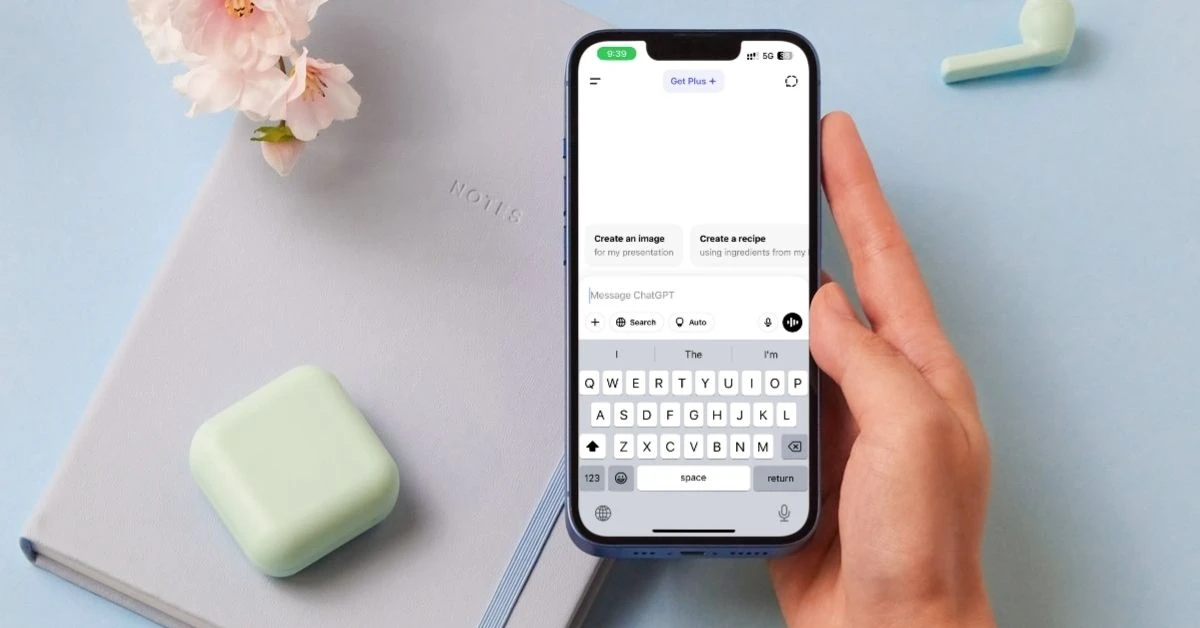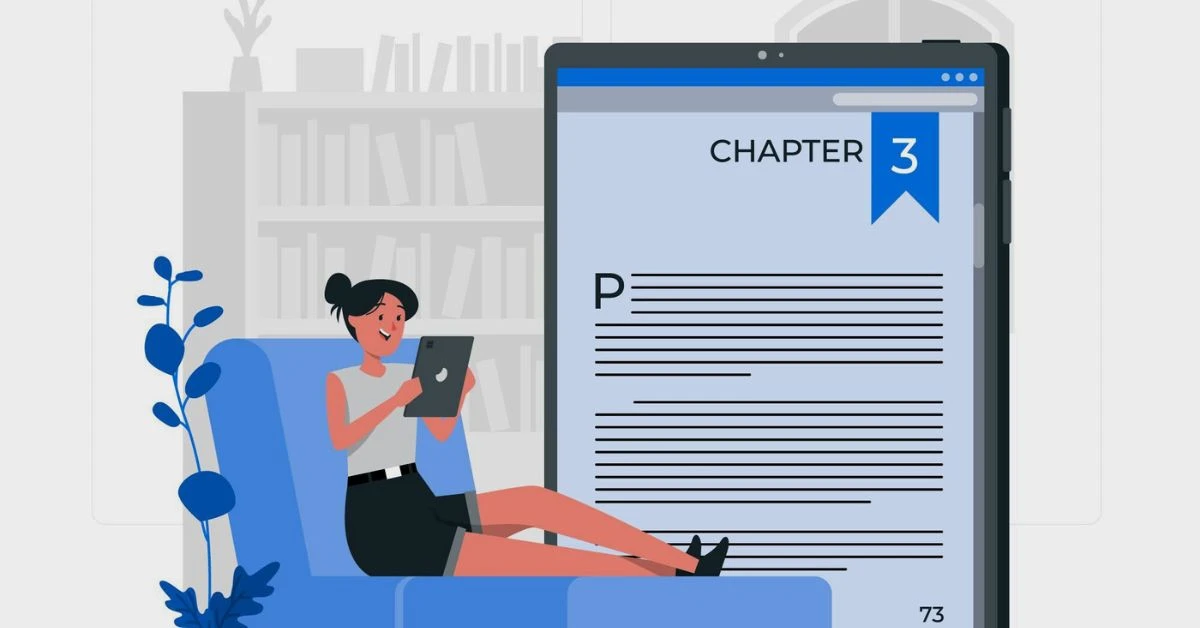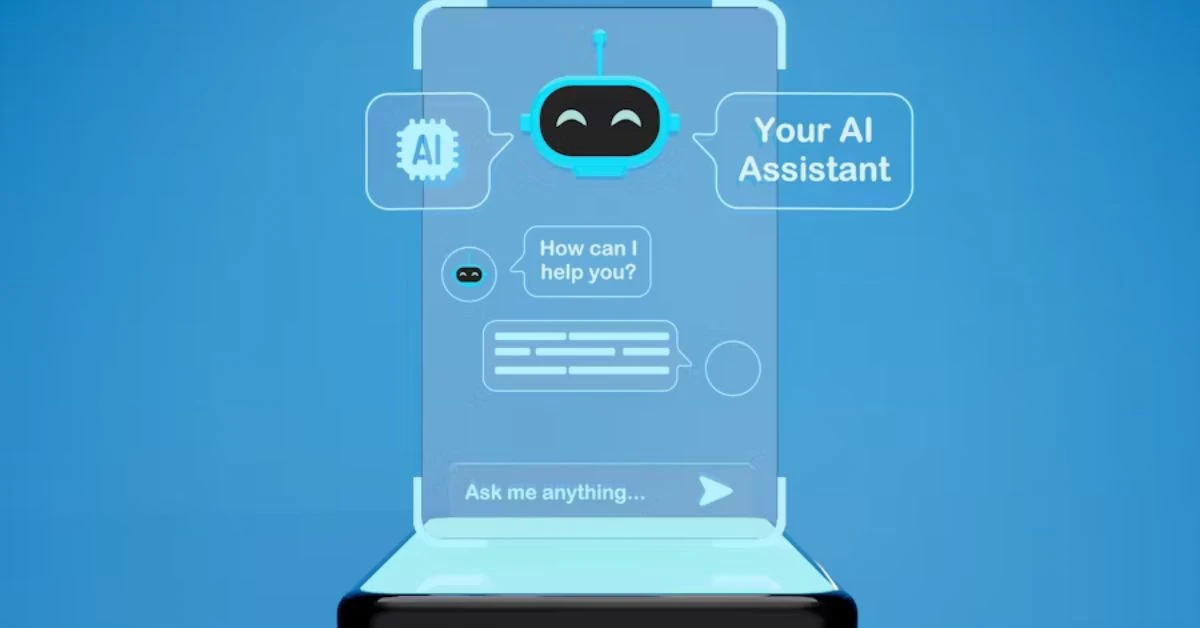How to Stop iPhone Apps from Tracking You (Ultimate Privacy Guide)
Let me tell you something that really bugged me a while back.
I downloaded a few random apps, tried them out for a day or two, and suddenly, I started seeing weirdly specific ads pop up.
On Safari, in other apps, and even inside games.
It felt like my iPhone was quietly whispering my habits to someone behind the scenes.
Turns out, it kinda was.
Most iPhone apps, yes, even the legit ones, try to track what you do, what you tap on, and sometimes even where you are.
It’s all for “better user experience,” they say.
But honestly, I didn’t sign up for that.
So I dove into every privacy setting I could find.
Tweaked things.
Switched stuff off.
And finally, things calmed down.
In this guide, I’m sharing everything I did to stop apps from tracking me on my iPhone.
Nothing techy, with no complicated steps.
Just simple settings anyone can use.
You might not realize how many little tracking switches are hiding in your phone… but once you flip them off, it feels good.
Why iPhone Apps Track You (And What It Means)
Here’s the deal: most iPhone apps aren’t just focused on giving you cool features.
They also want to learn from how you use them.
Some track you to show more relevant ads.
Others want to see which buttons you tap, which screens you stay on longer, or how often you open the app.
And yeah, some just want to collect data to sell to third parties.
It’s not always shady.
But it’s definitely not always necessary, either.
This is why, after casually searching for running shoes on Safari, you start seeing ads for Nike or Adidas in completely unrelated apps.
That moment of “Wait… how do they know?”
That’s tracking in action.
They don’t just follow what you do inside their own app.
With your permission (or sneaky workarounds), they try to track your activity across other apps and websites, too.
It’s called cross-app tracking, and iPhones used to allow it by default.
Thankfully, Apple changed that.
And now you’ve got options.
What Is App Tracking Transparency (ATT) in iOS?
A few iOS updates ago, Apple finally did something bold.
And honestly, long overdue.
They introduced something called App Tracking Transparency, or ATT for short.
Here’s how it works: Whenever you install or open an app that wants to track your activity outside of its own little world, your iPhone now asks you first. You’ve probably seen the pop-up before: Allow [App Name] to track your activity across other companies’ apps and websites?
You get two choices: Allow or Ask App Not to Track.
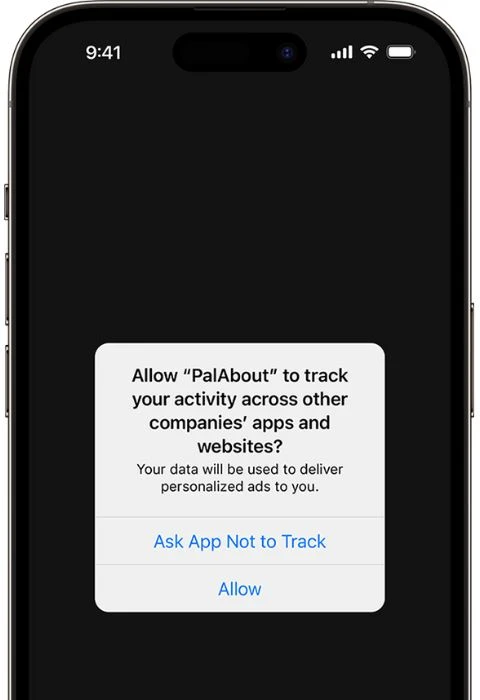
If you tap Allow, you’re basically giving that app a pass to follow you around and use your data for ads or analytics.
If you tap Ask App Not to Track, the app is blocked from collecting that kind of info, and Apple enforces it.
Before ATT, apps didn’t even need to ask.
They could quietly do their thing in the background.
But now, thanks to Apple, you’re in control.
How to Stop Apps from Tracking You
If you’re like me and just want to shut down tracking completely without waiting for every app to ask nicely, there’s a quick fix.
Apple actually gives you a master switch to block all tracking requests before they even pop up.
Once you flip it, apps won’t even get the chance to ask you for permission.
Here’s how to do it:
- Open Settings → Privacy & Security → Tracking → Allow Apps to Request to Track
- Just toggle that off. That’s it.

Once that’s turned off, your iPhone will automatically deny tracking requests from every app—past, present, or future.
Honestly, this is one of the first settings I turn off on any new iPhone.
It takes 10 seconds and instantly gives you more peace of mind.
Also read: How to install apps not available in your country on iPhone
How to Disable Tracking for Individual Apps
Alright, so maybe you already had tracking turned on before you found this guide.
No worries at all.
Even if you said “yes” to a few apps in the past, you can still take back that permission anytime you want.
iPhone makes it easy to go back and turn off tracking on a per-app basis.
Here’s how to do it:
- Go to Settings → Privacy & Security → Tracking
- Now, you’ll see a list of apps that have asked to track you
- Just switch off tracking for any app you don’t want snooping around
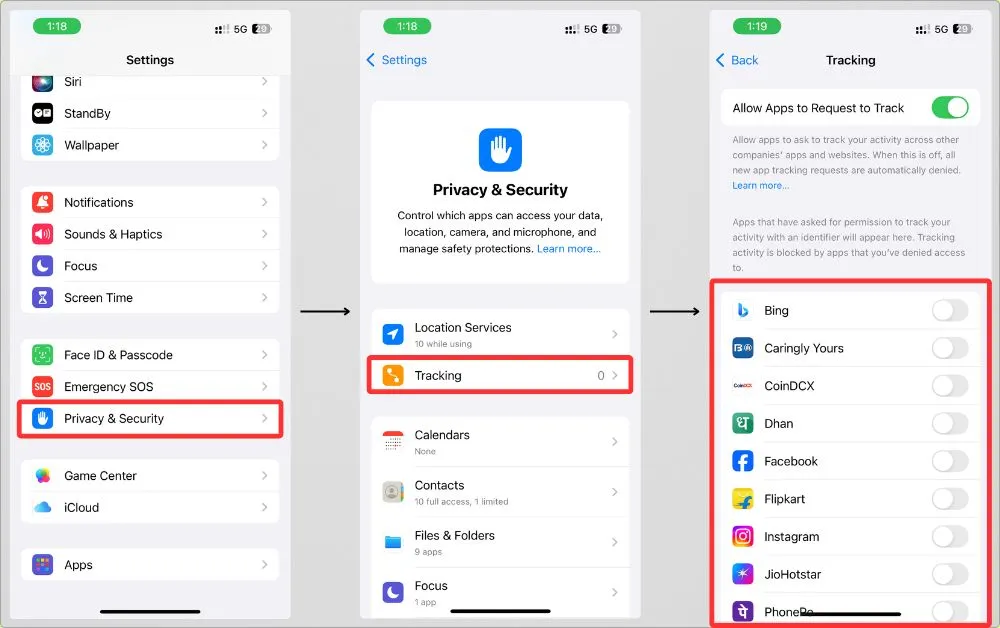
That’s it.
Personally, I keep this list short.
If I don’t trust the app or need personalized ads (which, let’s be real, I usually don’t), I just flip the switch off.
Some apps might try to nudge you later, saying, “Turn tracking back on for a better experience.”
You can just skip that.
You’re not missing much.
What Happens When You Disable Tracking? (Pros & Cons)
So, what really changes when you stop apps from tracking you?
Let me break it down in the simplest way possible: you lose nothing important, and gain a whole lot of privacy.
But just so you’re fully in the loop, here’s the honest picture.
What You Gain (The Pros):
- More privacy, less creepiness: No more feeling like your phone is reading your mind or spying on your late-night shopping habits.
- Less data floating around: Apps won’t be able to share your activity with ad companies or other apps.
- Fewer targeted ads: You’ll still see ads, but they won’t be laser-focused on what you searched five minutes ago.
What You Might Notice (The Cons):
- Ads may feel a little random: Instead of personalized promos, you might get more generic stuff (like a car ad when you don’t even drive).
- Some apps might bug you about it: Apps like Facebook and Instagram really want that data, so they might try to convince you to turn tracking back on. You can just ignore it.
- Slightly less personalized experiences: A few apps might not recommend things as accurately, but honestly? It’s barely noticeable.
In simple words, unless you really love hyper-targeted ads, turning off tracking is a no-brainer.
You’re not breaking anything.
You’re just choosing privacy over pointless personalization.
Stop Location Tracking by Apps
Even if you’ve blocked apps from tracking your activity, there’s one more way they might still keep tabs on you: your location.
Yep, some apps constantly ping where you are.
Whether you’re grabbing coffee, walking your dog, or just sitting at home scrolling.
And while some of them (like Maps or Uber) genuinely need your location to work, others really don’t.
So here’s how to lock that down and decide who really needs to know where you are.
To check which apps are tracking your location:
- Go to Settings → Privacy & Security → Location Services
- You’ll see a list of apps that have requested access to your location
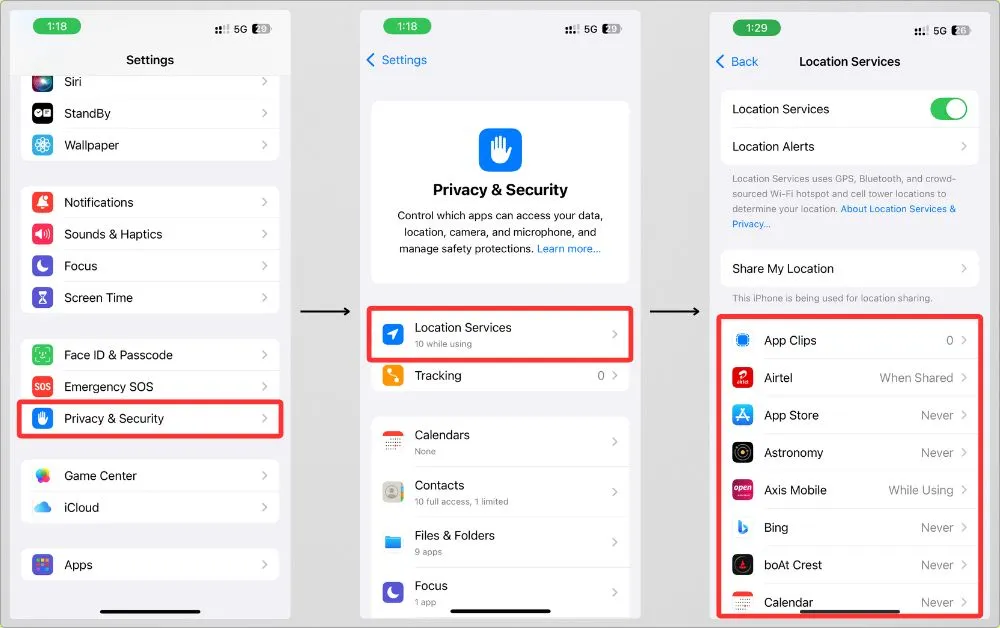
For each app, you can tap and choose from these options:
- Never – the app gets no access to your location
- Ask Next Time Or When I Share – the app will ask before using your location again
- While Using the App – only tracks when the app is open
- Always – tracks all the time (this one deserves a second thought)
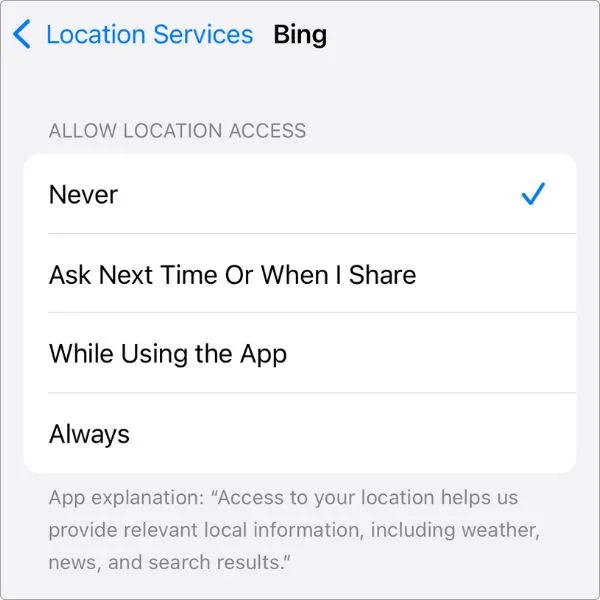
Bonus tip: Some apps also ask for Precise Location. You can toggle this off to give them a rough idea of where you are without sharing your exact GPS dot on the map.
Personally, I go through this list every few months and clean house.
Most apps don’t really need your location, so why give them access?
Turn Off Apple’s Own Tracking
Now, here’s something most people miss: Apple does some tracking too.
It’s nowhere near as aggressive as what third-party apps do.
But still, it quietly gathers bits of your data for things like ads, Siri improvements, and usage stats.
If you’re serious about privacy (which you clearly are if you’re reading this), it’s worth flipping a few more switches.
Let’s clean it up, step by step.
1. Turn Off Apple Ads
Apple shows ads in places like the App Store and Apple News.
They’re not creepy Facebook-style ads, but they are personalized based on your activity.
To turn this off:
- Go to Settings → Privacy & Security → Apple Advertising
- Toggle off Personalized Ads

That’s it.
You’ll still see ads, but they won’t be based on your App Store searches, purchases, or downloads.
2. Turn Off Apple Analytics
Apple also collects info about how you use your iPhone to help improve products.
But again, if you’re not cool with that, you can say no.
Here’s how to stop it:
- Open Settings → Privacy & Security → Analytics & Improvements
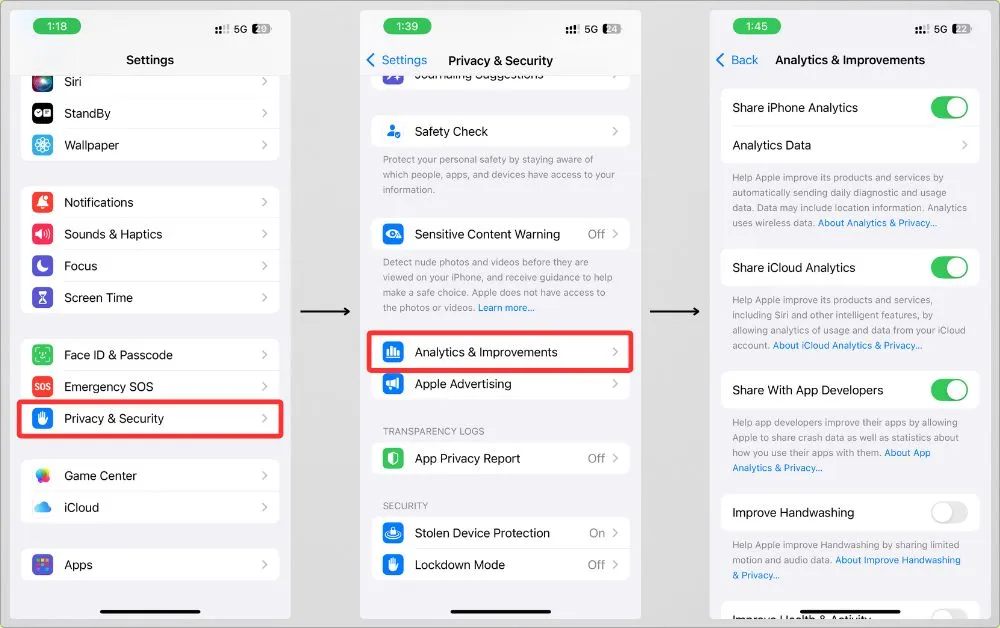
Now, turn off these three:
- Share iPhone Analytics
- Share with App Developers
- Improve Siri & Dictation
You’ll still get all the same features, minus the silent data sharing in the background.
Clean, simple, and 100% under your control.
Other Privacy Settings You Should Check
By now, you’ve handled the big stuff, but let’s take it a step further.
There are a few more settings buried inside your iPhone that are totally worth checking.
They’re quick fixes that tighten your privacy even more.
Here’s what I recommend going through:
1. Turn Off “Allow Apps to Access Your Contacts, Photos, etc.” (If Not Needed)
Some apps ask for access to your contacts, photos, camera, mic, or calendar, even when it’s not really necessary.
To review and clean that up:
- Go to Settings → Privacy & Security
- Choose any section like Contacts, Photos, Microphone, Camera, etc.
- Go through the list and turn off access for apps that don’t truly need it

I do this every now and then, and I always find a random app that doesn’t need what it’s asking for.
2. Limit Bluetooth & Local Network Access
Some apps use Bluetooth or try to connect to other devices on your local network, not always for the right reasons.
To check this:
For Bluetooth: Settings → Privacy & Security → Bluetooth

For Local Network: Settings → Privacy & Security → Local Network
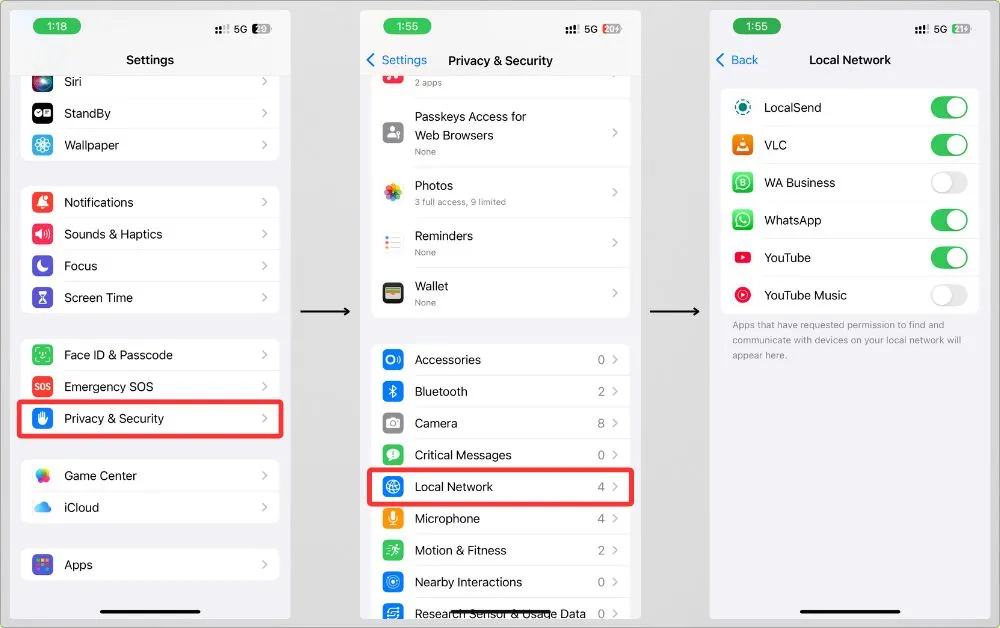
If anything looks off or unnecessary, switch it off.
3. Review Your App Privacy Reports (Optional but Cool)
Apple now gives you a built-in report of what apps are doing behind the scenes, like which websites they connect to, or how often they access your data.
You can turn it on here:
Settings → Privacy & Security → App Privacy Report
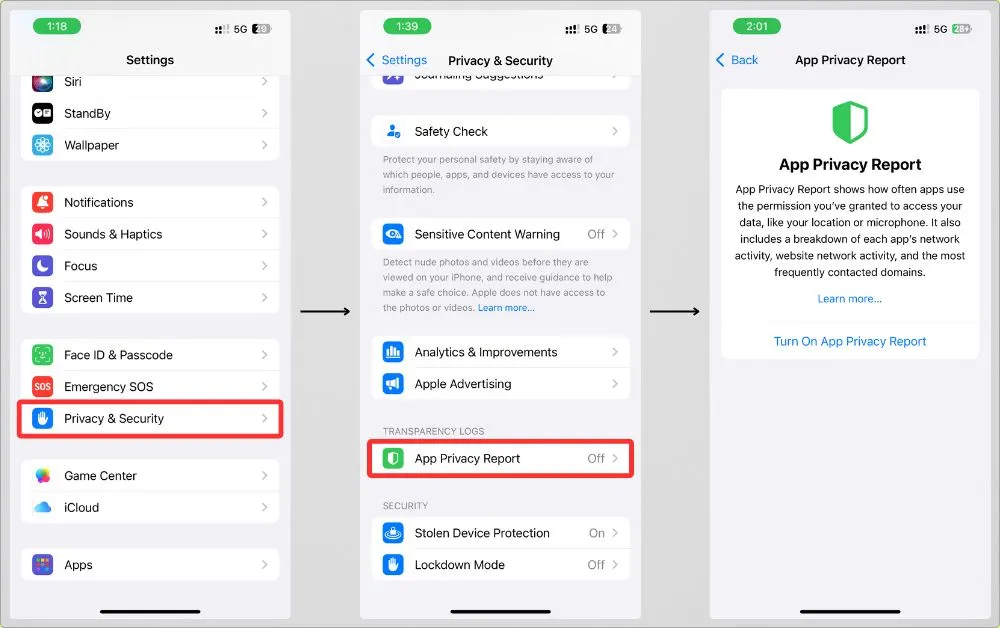
Let it run for a few days, then come back and take a peek.
You might be surprised at how often some apps are calling home.
These are little things, but they add up.
And once you clean them up, your iPhone just feels more yours.
Apps That Block Trackers
Alright, if you’ve followed everything so far, your iPhone is already in great shape.
But if you’re someone who wants to go the extra mile and block even more tracking at the source, there are a few tools that do exactly that.
These apps and features can catch stuff that slips through the cracks, even outside the usual settings.
1. Lockdown Privacy
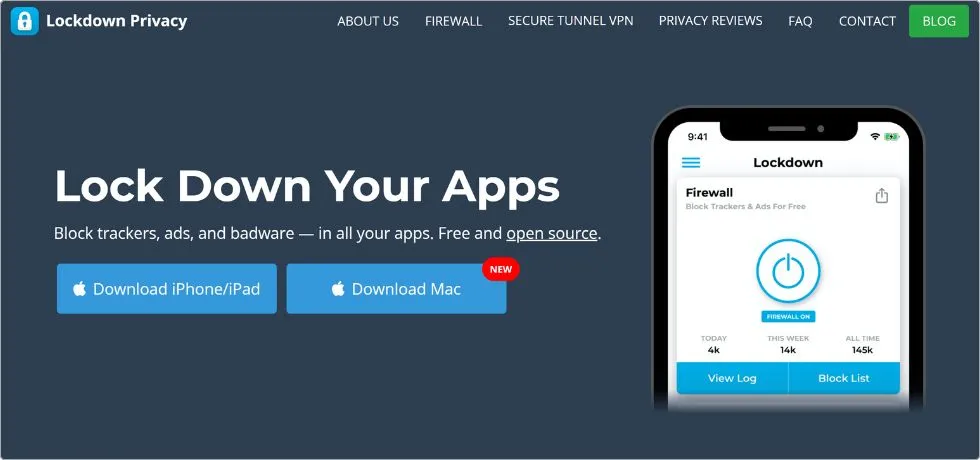
This is like a firewall for your iPhone.
It blocks known trackers system-wide, not just in Safari.
Once you set it up, it works quietly in the background.
I’ve tested this one, and it really cuts down on those sneaky background connections that apps try to make.
2. 1Blocker / AdGuard
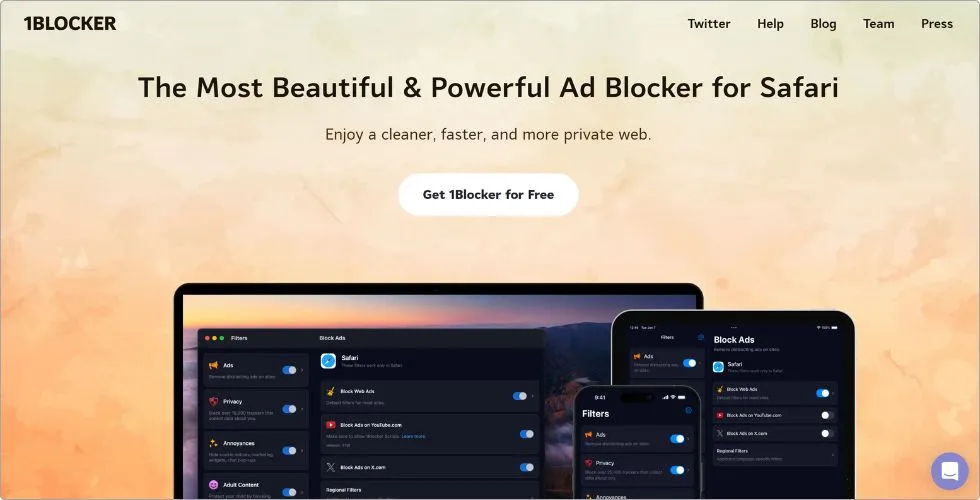
These are both great for one thing: blocking ads and trackers in Safari.
If you do a lot of browsing, these tools help pages load faster and cleaner, without those privacy-invading scripts running behind the scenes.
3. DuckDuckGo Privacy Browser
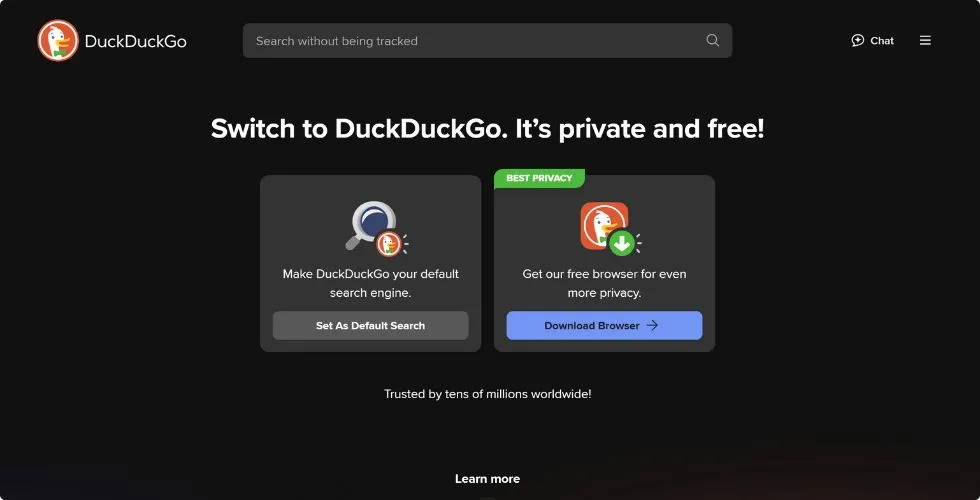
If you ever feel like Safari’s not doing enough, the DuckDuckGo browser is a solid alternative.
It blocks trackers by default, doesn’t store your search history, and even gives you a burn button to instantly wipe all your tabs and data.
I use it when I just want to search something without leaving a trace.
It allows you to browse the internet anonymously on an iPhone.
Bonus for iCloud+ Users: iCloud Private Relay
If you pay for iCloud+, you’ve got access to something called Private Relay.
It hides your IP address and encrypts your browsing in Safari, kind of like a mini VPN built into your phone.
To turn it on:
Settings → [Your Name] → iCloud → Private Relay
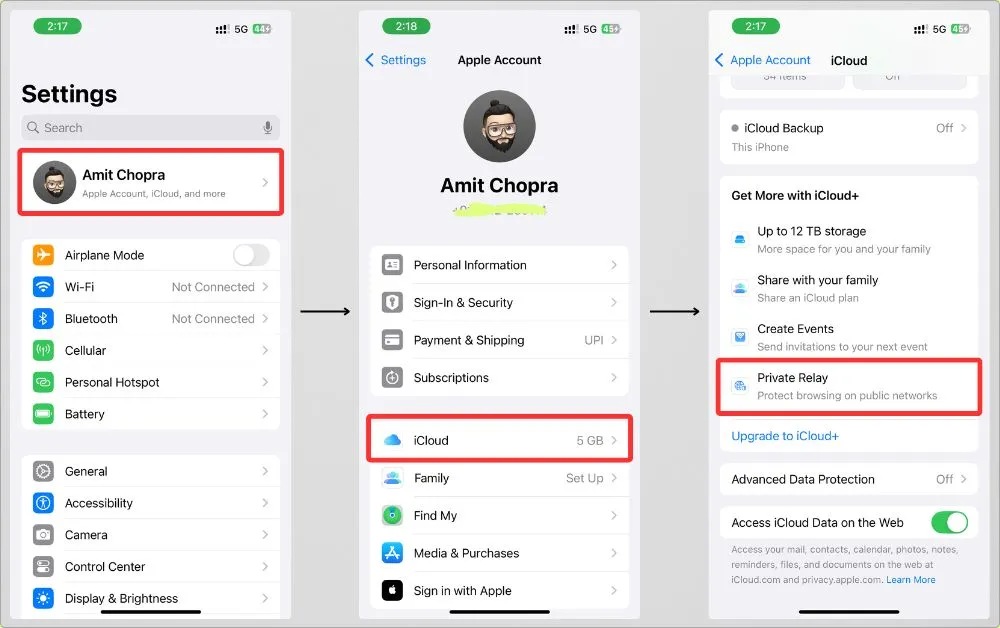
If it’s available in your region, it’s a simple toggle and totally worth using.
None of these are must-haves, but if you’re a privacy nerd (or just curious), they’re nice extras to have in your pocket.
Best Practices to Stay Private on iPhone
Privacy isn’t a one-time fix.
It’s more like a habit.
But the good news is, that you don’t need to be a tech genius to stay private.
Just a few mindful choices here and there can make a big difference.
Here’s how I personally keep my iPhone clean and private without overthinking it:
1. Don’t Tap “Allow” Without Thinking
When an app pops up asking to track you, don’t just hit Allow out of habit.
Take a second and ask yourself: Does this app really need to know what I’m doing in other apps?
Nine times out of ten, the answer is no.
2. Use Privacy Labels on the App Store
Before you download anything, scroll down and check the App Privacy section in the App Store listing.
It’ll tell you exactly what data the app wants to collect, things like location, usage data, or contact info.
If the list is a mile long for a simple calculator app… maybe skip it.
3. Regularly Review Your Privacy Settings
I set a reminder every couple of months to go back and check:
- Which apps have access to my location
- Who can see my photos or contacts
- Who I’ve (accidentally) allowed to track me
It takes five minutes, and totally worth it.
4. Avoid Sketchy Apps with Way Too Many Permissions
If an app is asking for everything, camera, mic, location, contacts, Bluetooth, calendar, your blood type (okay, not quite), that’s a red flag.
Stick to trusted apps with a clear purpose, especially when they’re free.
Remember: if you’re not paying for the product, you might be the product.
My Final Take
Look, you don’t need to become a privacy expert or live off the grid to take control of your iPhone.
You just need to care a little bit, and make a few smart tweaks here and there.
And that’s exactly what you’ve done by going through this guide.
Whether you turned off tracking, cleaned up app permissions, or just learned something new today, that’s a win.
And remember, this isn’t about being paranoid.
It’s about setting healthy boundaries with your tech.
Your iPhone should work for you, not the other way around.
So go ahead, use your phone like normal.
Browse, scroll, take pics, chat with your people… just with a little more confidence knowing you’ve taken back some control.
I’ll keep exploring more privacy tricks and hidden gems.
And I’ll always share them with you.
Have you got something to say, feedback, a question, or even a complaint?
The comment box is always open, and I’m always up for a good conversation.
And if you’re open to more guides, check out these:
- How to download older versions of apps on iPhone
- How to find hidden or removed apps on the App Store
- How to use ChatGPT on iPhone like a pro
Until then, stay safe, stay curious, and enjoy your (now much more private) iPhone.
FAQs
1. Can iPhone apps still track me if I choose Ask App Not to Track?
Not really. Apple blocks them from accessing your Identifier for Advertisers (IDFA), which is what most apps use for tracking. But some apps might still gather info through other means, which is why it’s smart to review other privacy settings too.
2. Do I need to block location access for every app?
Nope. Some apps like Maps, Uber, or Weather, need your location to work properly. Just make sure only those apps have access and set them to While Using the App instead of Always.
3. Is Apple tracking me too?
To some extent, yes. Apple uses analytics to improve services and personalize ads. But the good news is, you can turn most of that off, and we showed you exactly how in this guide.
4. Are free apps more likely to track me?
In general, yes. If you’re not paying for an app, it’s more likely they’re making money by collecting data and showing you ads. That doesn’t mean all free apps are bad, it just means you should check their permissions and privacy labels before downloading.
5. What is App Tracking Transparency?
It’s Apple’s feature that lets you control whether apps can track your activity across other apps and websites. When an app asks to track, and you say no, Apple enforces that limit at the system level.
6. What happens if I turn off all tracking and analytics?
You’ll still be able to use your iPhone and your apps normally, no worries there. You just might see less personalized ads, and Apple won’t get usage data to “improve” things like Siri or system features.
7. Do I need a VPN to stay private on my iPhone?
A VPN adds another layer of privacy, especially on public Wi-Fi, but it’s not required for basic app tracking protection. Apple’s Private Relay (if you have iCloud+) is a lightweight alternative for Safari browsing.
8. How often should I check my privacy settings?
Honestly? Once every couple of months is great. Things can change after app updates or iOS updates, so a quick check-in helps you stay in control without it becoming a chore.

